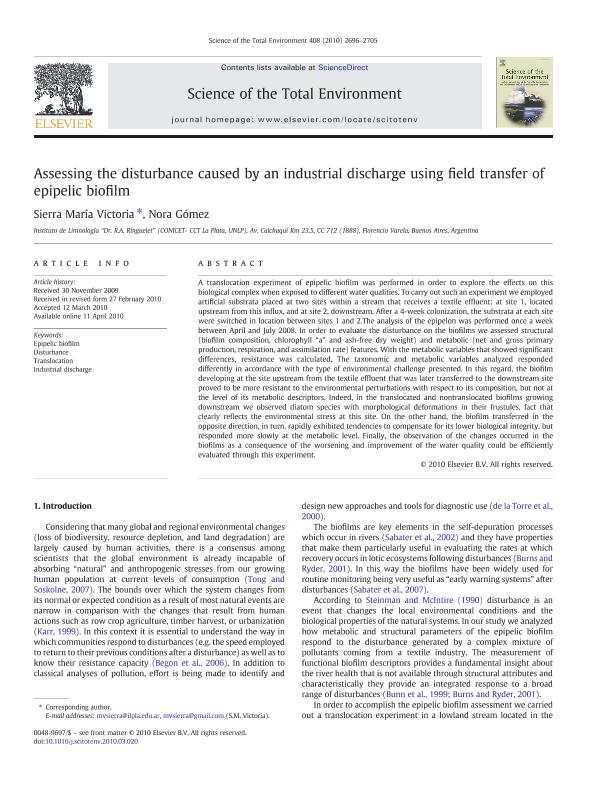Mostrar el registro sencillo del ítem
dc.contributor.author
Sierra, Maria Victoria

dc.contributor.author
Gomez, Nora

dc.date.available
2018-07-12T19:55:48Z
dc.date.issued
2010-06
dc.identifier.citation
Sierra, Maria Victoria; Gomez, Nora; Assessing the disturbance caused by an industrial discharge using field transfer of epipelic biofilm; Elsevier Science; Science of the Total Environment; 408; 13; 6-2010; 2696-2705
dc.identifier.issn
0048-9697
dc.identifier.uri
http://hdl.handle.net/11336/51932
dc.description.abstract
A translocation experiment of epipelic biofilm was performed in order to explore the effects on this biological complex when exposed to different water qualities. To carry out such an experiment we employed artificial substrata placed at two sites within a stream that receives a textile effluent: at site 1, located upstream from this influx, and at site 2, downstream. After a 4-week colonization, the substrata at each site were switched in location between sites 1 and 2.The analysis of the epipelon was performed once a week between April and July 2008. In order to evaluate the disturbance on the biofilms we assessed structural (biofilm composition, chlorophyll “a” and ash-free dry weight) and metabolic (net and gross primary production, respiration, and assimilation rate) features. With the metabolic variables that showed significant<br />differences, resistance was calculated. The taxonomic and metabolic variables analyzed responded differently in accordance with the type of environmental challenge presented. In this regard, the biofilm developing at the site upstream from the textile effluent that was later transferred to the downstream site proved to be more resistant to the environmental perturbations with respect to its composition, but not at the level of its metabolic descriptors. Indeed, in the translocated and nontranslocated biofilms growing downstream we observed diatom species with morphological deformations in their frustules, fact that clearly reflects the environmental stress at this site. On the other hand, the biofilm transferred in the opposite direction, in turn, rapidly exhibited tendencies to compensate for its lower biological integrity, but responded more slowly at the metabolic level. Finally, the observation of the changes occurred in the biofilms as a consequence of the worsening and improvement of the water quality could be efficiently evaluated through this experiment.
dc.format
application/pdf
dc.language.iso
eng
dc.publisher
Elsevier Science

dc.rights
info:eu-repo/semantics/openAccess
dc.rights.uri
https://creativecommons.org/licenses/by-nc-sa/2.5/ar/
dc.subject
Epipelic Biofilm
dc.subject
Disturbance
dc.subject
Translocation
dc.subject
Industrial Discharge
dc.subject.classification
Otras Ciencias Biológicas

dc.subject.classification
Ciencias Biológicas

dc.subject.classification
CIENCIAS NATURALES Y EXACTAS

dc.title
Assessing the disturbance caused by an industrial discharge using field transfer of epipelic biofilm
dc.type
info:eu-repo/semantics/article
dc.type
info:ar-repo/semantics/artículo
dc.type
info:eu-repo/semantics/publishedVersion
dc.date.updated
2018-07-11T15:13:03Z
dc.journal.volume
408
dc.journal.number
13
dc.journal.pagination
2696-2705
dc.journal.pais
Países Bajos

dc.journal.ciudad
Amsterdam
dc.description.fil
Fil: Sierra, Maria Victoria. Consejo Nacional de Investigaciones Científicas y Técnicas. Centro Científico Tecnológico Conicet - Santa Fe. Instituto Nacional de Limnología. Universidad Nacional del Litoral. Instituto Nacional de Limnología; Argentina
dc.description.fil
Fil: Gomez, Nora. Consejo Nacional de Investigaciones Científicas y Técnicas. Centro Científico Tecnológico Conicet - Santa Fe. Instituto Nacional de Limnología. Universidad Nacional del Litoral. Instituto Nacional de Limnología; Argentina
dc.journal.title
Science of the Total Environment

dc.relation.alternativeid
info:eu-repo/semantics/altIdentifier/url/https://www.sciencedirect.com/science/article/pii/S0048969710002676
dc.relation.alternativeid
info:eu-repo/semantics/altIdentifier/doi/http://dx.doi.org/10.1016/j.scitotenv.2010.03.020
Archivos asociados
